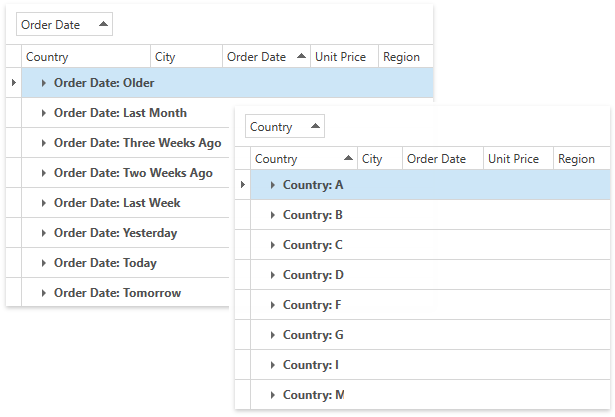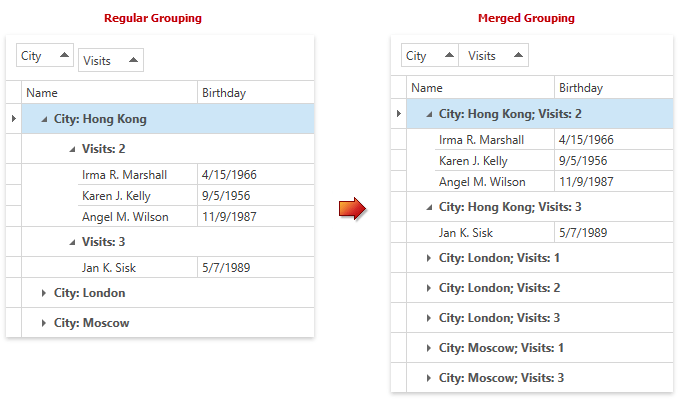Group Modes
Interval grouping
By default, when grouping by date/time values, only the date portion of values is taken into account, while the time portion is ignored. Rows that contain matching date portions, but different time portions in a grouping column, are combined into a single group.
The default grouping logic is used if grouping columns contain other data types. In this instance, rows are combined into a single group, if they have a matching value in a grouping column.
The Interval Grouping feature allows you to change the default logic. Use the column’s GridColumn.GroupInterval property to specify the required grouping mode.
The image below shows how the data rows can be arranged by the month or year part of a date/time value, or grouped by the first characters.

Merged Grouping
Set the GridViewBase.AllowMergedGrouping property to true to enable the Merged Grouping feature which allows grouping grid data by multiple columns at once.

Merged grouping can work in the following modes that you can specify using the GridViewBase.MergedGroupingMode property:
Custom Grouping
You can implement custom logic if the built-in grouping modes do not suit your requirements. Set the ColumnBase.SortMode property to Custom and handle the GridControl.CustomColumnGroup event.
You can handle the GridControl.CustomGroupDisplayText event to change the default text displayed within group rows.
Example
This example shows how to group rows using custom rules. When grouping by the 'Unit Price' column, the rows in this column that have values between 0 and 10 should be combined into a single group. Rows whose values fall between 10 and 20 should be combined into another group, etc.
<Window x:Class="DXGrid_CustomGrouping.Window1"
xmlns="http://schemas.microsoft.com/winfx/2006/xaml/presentation"
xmlns:x="http://schemas.microsoft.com/winfx/2006/xaml"
xmlns:dxe="http://schemas.devexpress.com/winfx/2008/xaml/editors"
xmlns:dxg="http://schemas.devexpress.com/winfx/2008/xaml/grid"
Title="Window1" Height="300" Width="509">
<Grid>
<dxg:GridControl x:Name="grid"
CustomColumnGroup="grid_CustomColumnGroup"
CustomGroupDisplayText="grid_CustomGroupDisplayText"
ItemsSource="{Binding ListPerson}"
>
<dxg:GridControl.Columns>
<dxg:GridColumn FieldName="FirstName" />
<dxg:GridColumn FieldName="LastName" />
<dxg:GridColumn FieldName="UnitPrice" SortMode="Custom" GroupIndex="0">
<dxg:GridColumn.EditSettings>
<dxe:SpinEditSettings DisplayFormat="c2" />
</dxg:GridColumn.EditSettings>
</dxg:GridColumn>
</dxg:GridControl.Columns>
<dxg:GridControl.View>
<dxg:TableView AutoWidth="True" />
</dxg:GridControl.View>
</dxg:GridControl>
</Grid>
</Window>
Imports System
Imports System.Collections.Generic
Imports System.Collections.ObjectModel
Imports System.Linq
Imports System.Text
Namespace DXGrid_CustomGrouping
Public Class MyViewModel
Public Sub New()
CreateList()
End Sub
Public Property ListPerson() As ObservableCollection(Of Person)
Private Sub CreateList()
ListPerson = New ObservableCollection(Of Person)()
For i As Integer = 0 To 99
Dim p As New Person(i)
ListPerson.Add(p)
Next i
End Sub
End Class
Public Class Person
Public Sub New()
End Sub
Public Sub New(ByVal i As Integer)
FirstName = "FirstName" & i
LastName = "LastName" & i
UnitPrice = i
End Sub
Private _firstName As String
Public Property FirstName() As String
Get
Return _firstName
End Get
Set(ByVal value As String)
_firstName = value
End Set
End Property
Public Property LastName() As String
Private _age As Integer
Public Property UnitPrice() As Integer
Get
Return _age
End Get
Set(ByVal value As Integer)
_age = value
End Set
End Property
End Class
End Namespace
Imports System
Imports System.Collections.Generic
Imports System.Linq
Imports System.Text
Imports System.Windows
Imports System.Windows.Controls
Imports System.Windows.Data
Imports System.Windows.Documents
Imports System.Windows.Input
Imports System.Windows.Media
Imports System.Windows.Media.Imaging
Imports System.Windows.Navigation
Imports System.Windows.Shapes
Imports System.Collections
Imports DevExpress.Xpf.Grid
Namespace DXGrid_CustomGrouping
''' <summary>
''' Interaction logic for Window1.xaml
''' </summary>
Partial Public Class Window1
Inherits Window
Public Sub New()
InitializeComponent()
Me.DataContext = New MyViewModel()
End Sub
Private Sub grid_CustomColumnGroup(ByVal sender As Object, ByVal e As CustomColumnSortEventArgs)
If e.Column.FieldName = "UnitPrice" Then
Dim x As Double = Math.Floor(Convert.ToDouble(e.Value1) / 10)
Dim y As Double = Math.Floor(Convert.ToDouble(e.Value2) / 10)
Dim res As Integer = Comparer.Default.Compare(x, y)
If x > 9 AndAlso y > 9 Then
res = 0
End If
e.Result = res
e.Handled = True
End If
End Sub
Private Sub grid_CustomGroupDisplayText(ByVal sender As Object, ByVal e As CustomGroupDisplayTextEventArgs)
If e.Column.FieldName <> "UnitPrice" Then
Return
End If
Dim groupLevel As Integer = grid.GetRowLevelByRowHandle(e.RowHandle)
If groupLevel <> e.Column.GroupIndex Then
Return
End If
Dim interval As String = IntervalByValue(e.Value)
e.DisplayText = interval
End Sub
' Gets the text that represents the interval which contains the specified value.
Private Function IntervalByValue(ByVal val As Object) As String
Dim d As Double = Math.Floor(Convert.ToDouble(val) / 10)
Dim ret As String = String.Format("{0:c} - {1:c} ", d * 10, (d + 1) * 10)
If d > 9 Then
ret = String.Format(">= {0:c} ", 100)
End If
Return ret
End Function
End Class
End Namespace
using System;
using System.Collections.Generic;
using System.Collections.ObjectModel;
using System.Linq;
using System.Text;
namespace DXGrid_CustomGrouping {
public class MyViewModel {
public MyViewModel() {
CreateList();
}
public ObservableCollection<Person> ListPerson { get; set; }
void CreateList() {
ListPerson = new ObservableCollection<Person>();
for (int i = 0; i < 100; i++) {
Person p = new Person(i);
ListPerson.Add(p);
}
}
}
public class Person {
public Person() {
}
public Person(int i) {
FirstName = "FirstName" + i;
LastName = "LastName" + i;
UnitPrice = i ;
}
string _firstName;
public string FirstName {
get { return _firstName; }
set {
_firstName = value;
}
}
public string LastName { get; set; }
int _age;
public int UnitPrice {
get { return _age; }
set { _age = value; }
}
}
}
using System;
using System.Collections.Generic;
using System.Linq;
using System.Text;
using System.Windows;
using System.Windows.Controls;
using System.Windows.Data;
using System.Windows.Documents;
using System.Windows.Input;
using System.Windows.Media;
using System.Windows.Media.Imaging;
using System.Windows.Navigation;
using System.Windows.Shapes;
using System.Collections;
using DevExpress.Xpf.Grid;
namespace DXGrid_CustomGrouping {
/// <summary>
/// Interaction logic for Window1.xaml
/// </summary>
public partial class Window1 : Window {
public Window1() {
InitializeComponent();
this.DataContext = new MyViewModel();
}
private void grid_CustomColumnGroup(object sender,
CustomColumnSortEventArgs e) {
if (e.Column.FieldName == "UnitPrice") {
double x = Math.Floor(Convert.ToDouble(e.Value1) / 10);
double y = Math.Floor(Convert.ToDouble(e.Value2) / 10);
int res = Comparer.Default.Compare(x, y);
if (x > 9 && y > 9) res = 0;
e.Result = res;
e.Handled = true;
}
}
private void grid_CustomGroupDisplayText(object sender,
CustomGroupDisplayTextEventArgs e) {
if (e.Column.FieldName != "UnitPrice") return;
int groupLevel = grid.GetRowLevelByRowHandle(e.RowHandle);
if (groupLevel != e.Column.GroupIndex) return;
string interval = IntervalByValue(e.Value);
e.DisplayText = interval;
}
// Gets the text that represents the interval which contains the specified value.
private string IntervalByValue(object val) {
double d = Math.Floor(Convert.ToDouble(val) / 10);
string ret = string.Format("{0:c} - {1:c} ", d * 10, (d + 1) * 10);
if (d > 9) ret = string.Format(">= {0:c} ", 100);
return ret;
}
}
}
See Also

